Guess what is that one thing that is common between the temples of Hampi and the ones in Ranakpur. In fact, it is the same thing in any heritage temple of India. It is the question – “How did the artisans of the yester-years create these magnificent structures?“. While I still seek the answer to “How” in terms of the method, I partially discovered “where” they manage to perfect the craftsmanship. I found the ancient school of temple architecture in Aihole.

I meant to write this blog post earlier – in fact, post my visit to Badami, but the details were so overwhelming. It took me a while to sort it all out in my head. With this post, I embark on a series covering the schools of architecture across 3 locations – Aihole, Pattadakal & Badami. These three places are a heritage trail in North Karnataka that can be covered in a single trip. While Pattadakal is deemed as the place of graduation, Badami is like a high school of architecture. Nevertheless, Aihole is where it all begins.

Though a small village, Aihole can be quite a mind-boggling journey. I underestimated its beauty and spent only half a day here. Trust me – that was not enough for I left it incomplete. Even as a primary school, the work of its artisans will leave you spell-bound. Enough for you to mark as one of the must-visit destinations in Karnataka.
Contents
History of Aihole
Nope…it is not pronounced as “I Hole”. It is actually – “I – Ho – Lay”. Back in the 4th century, Aihole was also, called Aryapura. This has been mentioned in the Aihole inscriptions. While physical proof dates Aihole to the 4th century, it is believed to have come to existence much before that. Indian Mythology has it that Lord Parashurama – one of the 9 avatars of Vishnu came here after a battle. He reached the River Malaprabha and washed his blood-stained axe. It caused the river and the rest of the hill turn to red. A lady saw this and exclaimed – “Ayyo Hole” (Oh No, Blood) And thus, the current name.

During the Chalukya period, this mini town became a center for architecture and sculpture. From the 4th century to the late 13th century, it flourished as a place where numerous temples were built. Different types of carvings, temple layouts, and architectural styles were created. These were almost like prototypes for the actual temples built across India – both north and south. The expert students were later engaged in Badami and finally, the masters graduated in Pattadakal.
The temples here were not just Hindu. They were also, Jain and Buddhist ones. From elaborate temple complexes to single buildings and even cave temples, every possible combination was built here. It wasn’t just the exteriors but the intricate wall carvings, stunning idols and fascinating ceilings that were practiced.

The area was invaded in the 13th century and the exceptional work was ravaged by the Muslim invaders. Some of the temples were converted to military homes and bases. And thus came the decline of Aihole. It changed numerous hands before it finally landed in the hands of the British. Aihole remained neglected till the 20th century when the archaeological significance of the place came forth. Since then, numerous excavations were done and restored.
Today, with over 120 temple complexes, Aihole is a significant destination in the heritage trail of North Karnataka. It is here that you can trace the origins of many designs that you have admired in the popular Hindu, Jain and Buddhist temples of India. That is how you will be able to answer the key question of how they were created – but partially!
Places to see in Aihole
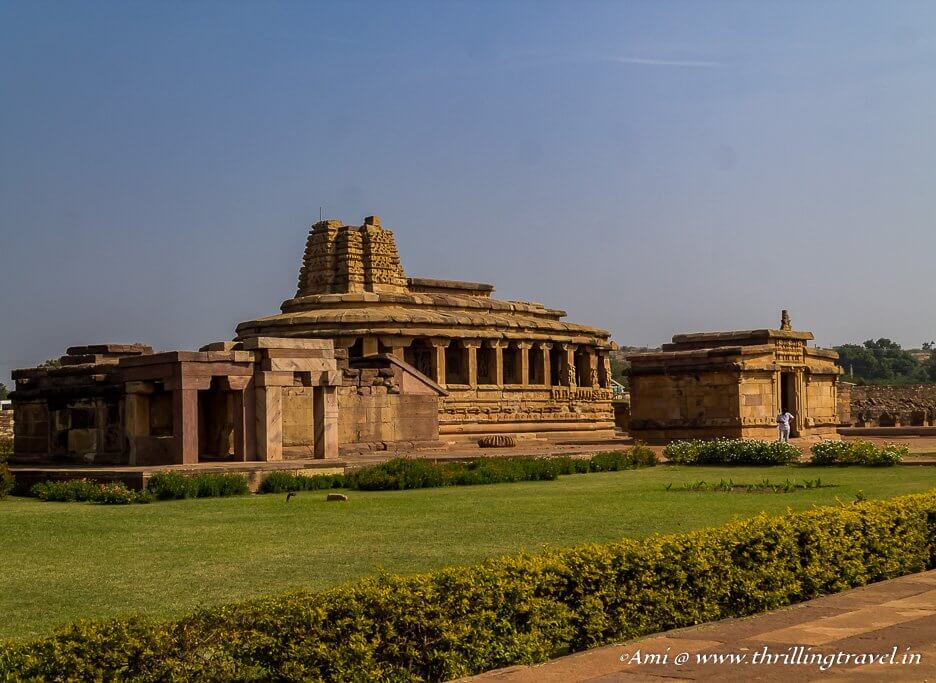
A large temple welcomed us into Aihole. However, that did not seem to be the first stop for this destination. For one, there was a tourist bus in front of us that seemed to move forth to a different temple complex. And for another, there were helpful signboards egging us towards what was termed as the main temple – Durga Temple Complex. A large ticket window at this temple complex introduced us to the history of Aihole while giving us a list of places that we need to visit when here.
Summarizing it for you –
- Durga Temple Complex
- Ambigergudi Temple Complex
- Jyotirlinga group of temples
- Meguti Jain Temples
- Ravanaphadi Cave Temple
- Mallikarjuna group of Temples
- Huchimalli Temple Complex
- Huchappayya Gudi
- Galaganatha group of temples
- Hucchappaya temple complex
- Chikki Temple
- Rachi Temple
- Eniyar Temple Complex
- Kunti Temple Complex
- Charanti Math Complex
- Ramalinga group of temples
I am pretty sure that you are overwhelmed just seeing this list. However, take this as a prep for what you are going to experience. In fact, please take this as your indicator to spend at least a day here. I made a mistake of just budgeting half a day and yes, I did not manage to see all of them. In any case, am sure you will enjoy a tour of what I did manage to see.
Durga Temple Complex
This is the focal point of Aihole. The Durga Temple Complex consists of around 12 Hindu temples – each one with a different architectural style. They all have been dated back to the era between 6th and 8th century. The place can easily take up a majority of your time in Aihole.
Durga Temple
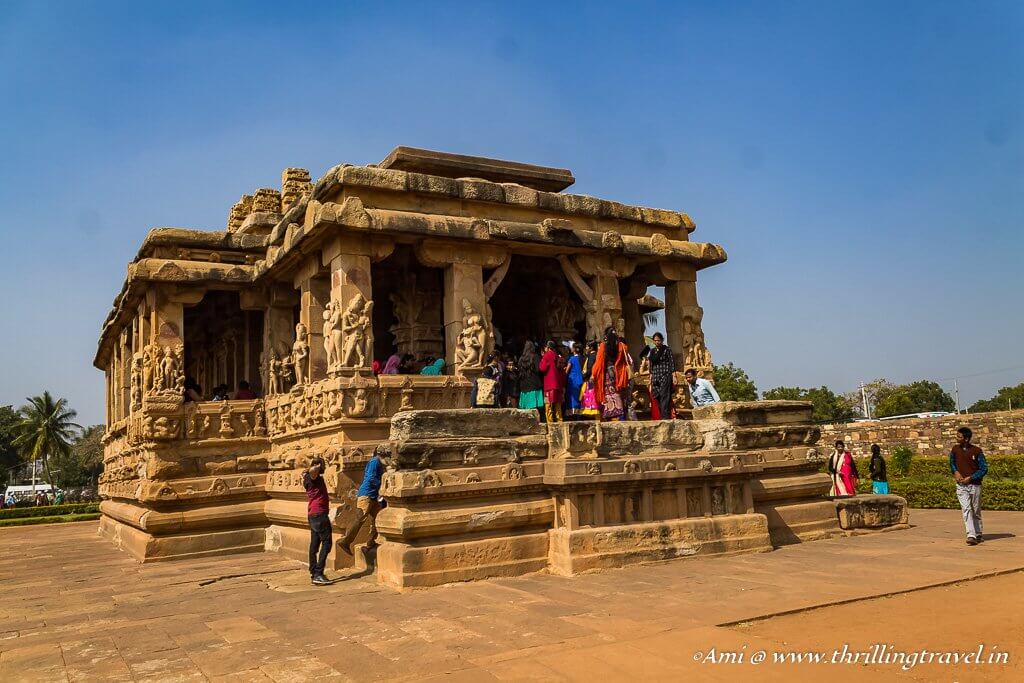
If you are expecting this temple to be dedicated to Goddess Durga, I would love to share how wrong you are. Durga here refers to Durg – which means a fort. The oblong temple with a flat roof was more than just a temple. They say that it was used as a lookout – possibly by the Marathas who won back Aihole from the Muslim rulers. Right now, you will find Lord Shiva as the presiding deity. However, it is said to have been built for Lord Surya originally.

Built in the typical Dravidian style, the Durga Temple of Aihole had a very simple structure. The outer shrine called the Mukhmantapa that was used as a community hall and the inner sanctum – Garba Griha with the Shiva Linga. The Mukhamantapa had a circular path that allowed the devotees to walk around in a clockwise direction (called Parikrama). In fact, now it is the path that every visitor to the temple needs to take – not just to offer respects but to admire the ancient handiwork.

Elaborate portraits of the Hindu Deities decorate the outer walls of Mukha mandapa. From Vishnu to Krishna and the beautiful but fierce Durga in her Mahishasura Mardini pose, walking around and observing this is nothing short of a visit to an open-air gallery. For those who have visited the various other Chalukya and Vijayanagara temples, you will be able to spot the similarities in the actual temples. I could not help but go back to my own visits to Hoysaleshwara Temple of Halebid, the Brihadeeswarar temple of Tanjore and the Hampi temples.
The art that was fine tuned here can be seen its complete glory across various Hindu Temples of India. If you are curious to know what they look like, check out my pictures of Hoysaleshwara Temple in Halebid & the BrihadeeswararTemple of Tanjore.
The roof of the temple seemed to be incomplete. Possibly collapsed over the years. However, this was another point of how they might have practiced the design before beautifully executing it in the Brihadeeshwara temple.




A lone Nandi faces the Linga inside the Garbha Griha. However, it is around the Nandi that keep an eye out. Trace the elaborate pillars from the ground to the ceiling and you will see the magic of the Naga Deva (Snake God). The same deity forms the lintel atop the entrance to the Garbha Griha.
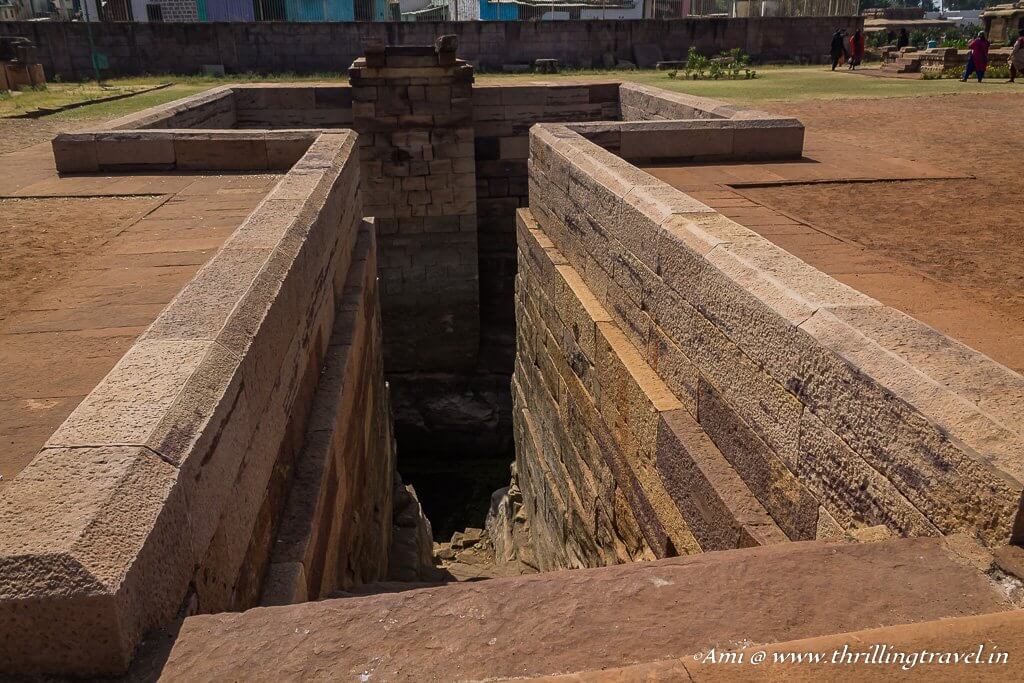
In a lot of ways, the Durga temple is a mini model of many temples for it has all the elements of a typical Hindu temple. Besides the main temple, it has its own gateway – though not as elaborate as the finished temples of Chalukya. It even has a customary step well or Pushkarni for its devotees to wash before their prayers. If you actually note, you can see a complete pattern of temple architecture that was used over centuries in India.
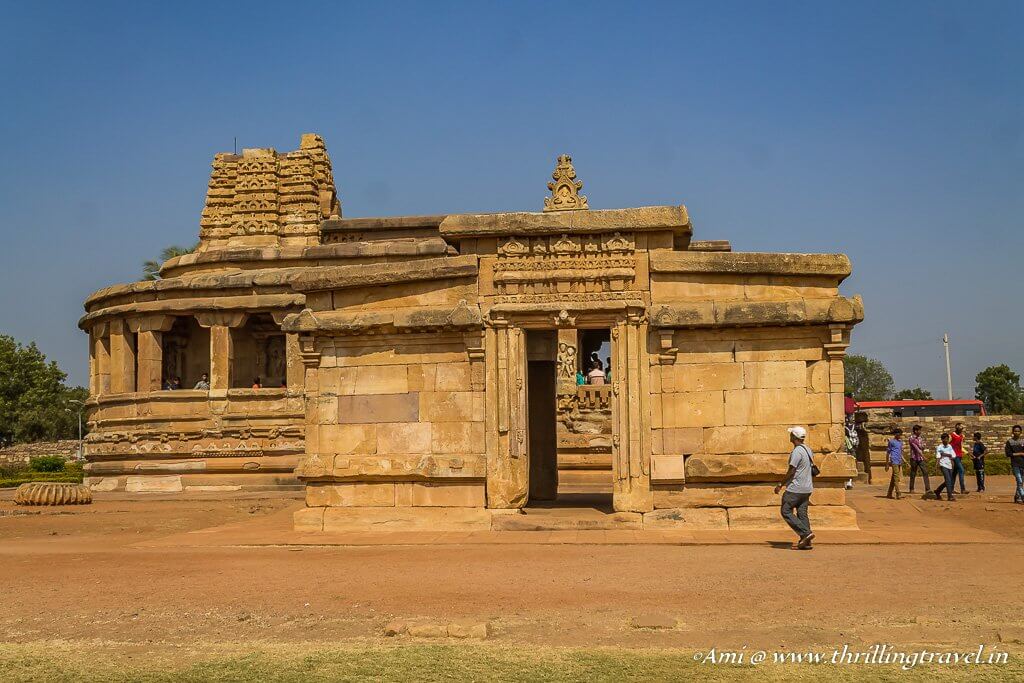
Lad Khan Temple
The temple might have been called something else earlier but its current name stuck to it after Lad Khan – a military commander in the Adil Shahi dynasty took up the place as his residence. Not only did he stay here, but used this temple as a base for his military operations.

Dedicated to Lord Shiva, the Ladkhan temple of Aihole is built in 3 concentric squares. The outer shrines formed the Mukhmandapa (also, called Sabhamandapa or community hall). These were typical of its carved pillars and ceilings – the most prominent theme of the art being flowers. The extreme outer walls had plenty of carvings – some quite erotic. Watch out for the emblem of the Chalukya – the Varaha.



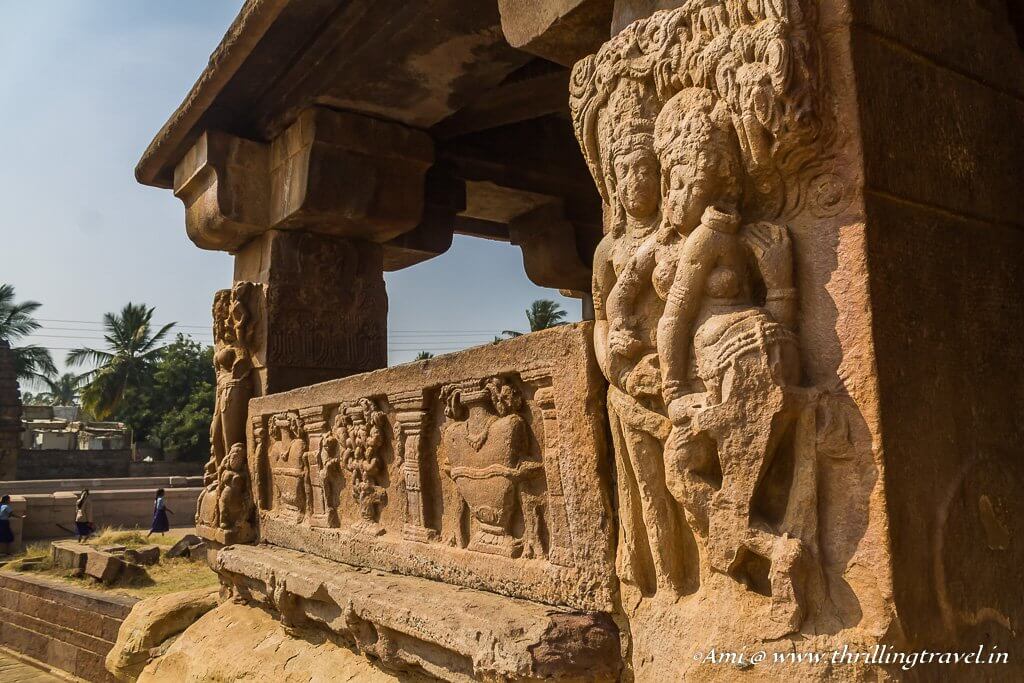
The Ladkhan temple is quite unlike the Durga temple in its architectural style. This particular one is built in a typical North Indian temple style. You can gauge this by the design of its flat roof and the lattice windows within. The windows allowed the temple within to be lit up by natural light.

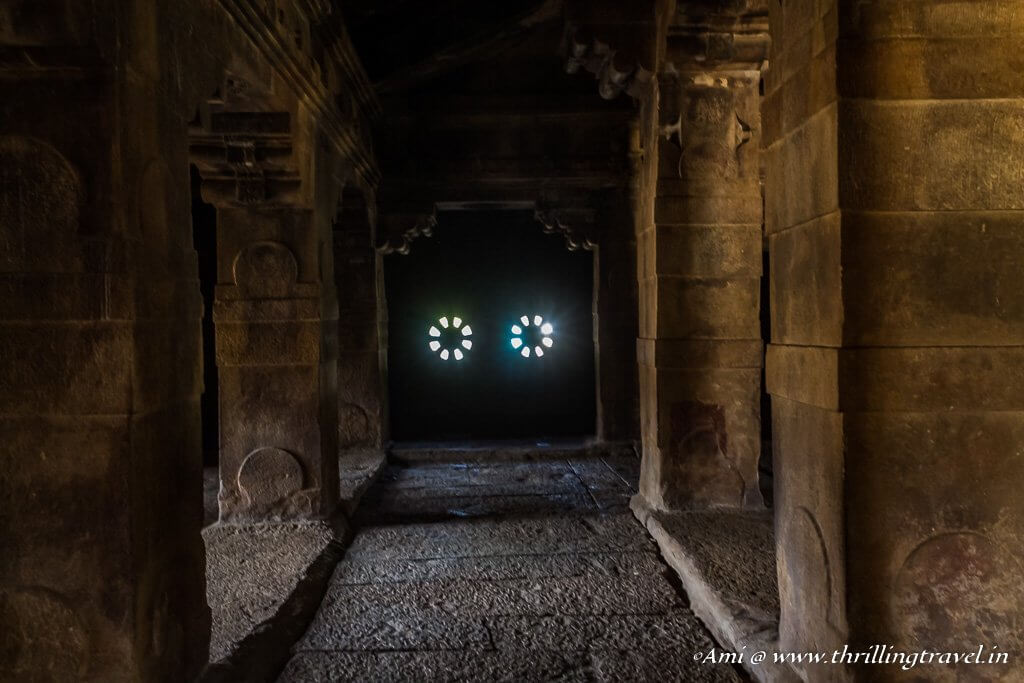
At the center of the Mukhmandapa is a large Nandi facing his Lord. Flanking the doors of the inner sanctum are carved figures of Ganga and Yamuna while the lintel atop has Garuda carrying his Lord Vishnu.
Chappara Gudi

Gudi means temple and Chappara means thatched roof. One look at the temple and you know why it is called so. In fact, from afar, I did not even deem it as a temple. Don’t make a mistake of just seeing it from the outside. A quick visit within will allow you to see very different kind of temple pillars. Devoid of any deity carvings, even the entrance to its sanctum santorum was different – like the typical lattice window screens.

Suryanarayana Gudi

It is likely that you might find this structure an ordinary looking ruin that possibly did not have anything of significance. The simple Suryanarayana temple in the Durga Temple complex belies its appearance. Within the temple is a 2 feet statue of Lord Surya with Ganga and Jamuna flanking it. The beautiful statue is lit by sunlight while all around it is darkness. The only opening that I saw was the door but that does not explain why the rest of the temple is dark.
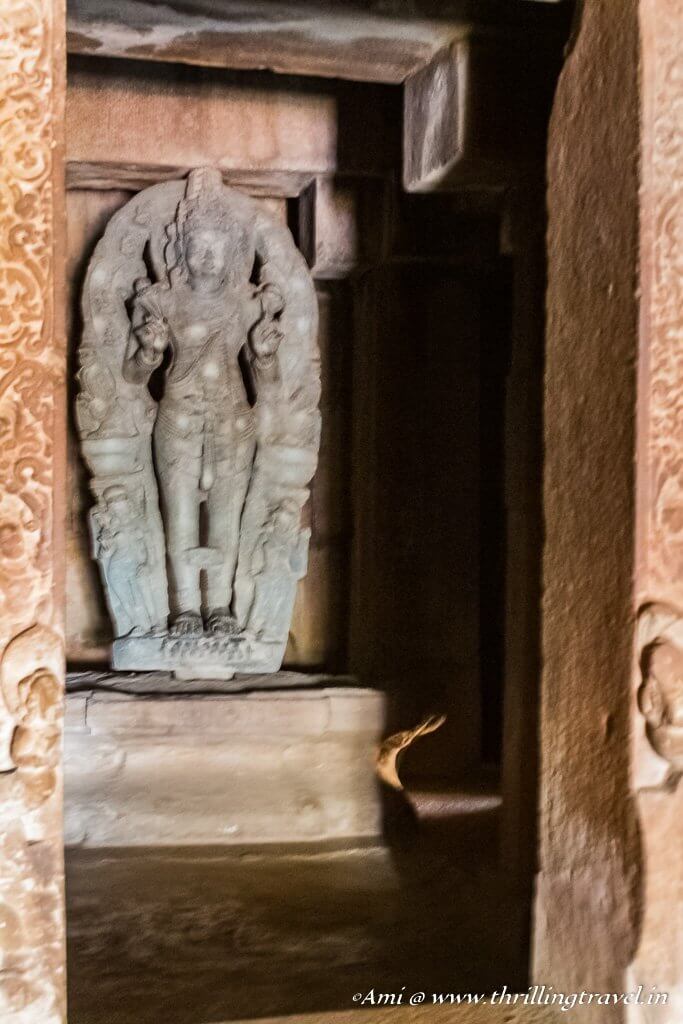
I am pretty sure that now that you know of this miracle, you won’t miss going in. And when you do. remember to look up at the Garuda on the entrance to the inner shrine.
Gaudara Gudi Temple

Right next to the Ladkhan temple, this one has a huge temple courtyard – quite like a lot of other Hindu temples today. The temple itself has an outer passage that allowed its devotees to do parikrama (walking clockwise) around the entire structure. The temple has a flat roof and is dedicated to Goddess Gauri (Goddess Parvati). This temple I believe is the oldest one among the Durga Temple Complex. It dates back to the 5th century.
Chakra Gudi

The Chakra Gudi temple has a very distinct Shikhar or temple roof. The base is very Dravidian while at the top there is a dome kind of structure. I believe that is what makes it Nagara style. This was built in the 8th century and around its main shrine has 20 erotic sculptures.
Badiger Gudi

The partial pyramid roof with an image of the Sun God – Lord Surya in it is what will identify this temple. It is opposite to the stepwell between Chakra Gudi temple and Gaudara Gudi temple. The temple name literally means “Carpenter’s temple” and as you might have guessed – a carpenter and his family stayed here for a long time. There isn’t much left within the temple to see – most of the artwork has been destroyed.
Nadyar Gudi


This particular temple is closer to the Durga Temple. The distinguishing feature of this temple is that it has three shrines. Though most of the structure within is lost to time, you can still see its huge cylindrical pillars. Our guide mentioned that this was typical of Hoysala architecture, which I can now agree to. You see, I went back to my visit to Chennakesava temple of Belur to confirm. You too can check out the similarity.
Unidentified Temples

There were a few structures that seemed interesting enough but did not seem to have any name. They were in fact labeled as nameless structures. However, you cannot miss them for their pretty work. Like these twin temples that reminded me of the Chariot temple or the Ratha Temples of Mahabalipuram.
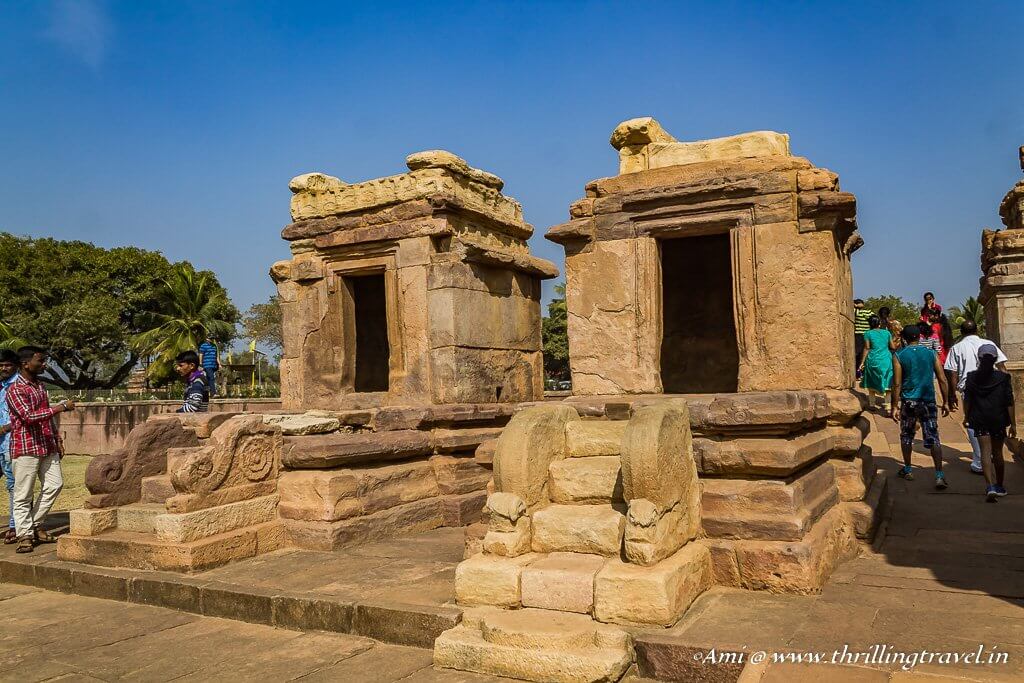

Or maybe this one, with its elaborate Shikhar. It struck me as a possible prototype for the Gopurams that I have seen in Tanjore or Hampi.
Step Wells of Aihole

The Durga Temple Complex is not just about temples. Within it are two stepwells. The first one is the T-shaped one that is a part of the main Durga temple. However, it is the 2nd one that is found between Chakri Gudi and Gaudara Gudi temple that is the most impressive. Huge and symmetrical, this one has carvings along its walls. You can walk right down its stairs to observe the elaborately etched face of Lord Naga.
Archaeological Museum

Don’t miss the museum within the Durga Temple Complex. It is home to the exquisite treasures that have been found during the excavation of Aihole. Some of these can be seen just outside the museum itself in the form of carved idols from the Hindu, Jain and Buddhist faiths. Within the museum, you will find a map of entire Aihole that will showcase the extent of history this village holds. Watch out for a huge idol of Lajja Gauri. She represents a birthing mother on a lotus.:-)
Ambigergudi Temple Complex

As you exit the Durga Temple Complex, you will see another set of ruins right across. The Ambigergudi group of temples has three temples within its compound. They seem to be dedicated to Lord Shiva and Lord Surya. These too, are typical of Dravidian architecture and have been built in the 6th to 11th century period.
A lot of the structures within are destroyed and it was actually, hard for me to figure out anything distinguishable here. There was only this lone idol of Lord Surya in one of the shrines. I really wished that I had a guide for I had this feeling that in my ignorance of what I saw, I might have missed something.
Jyotirlinga Complex

This group has around 16 temples dedicated largely to Lord Shiva. As I walked into the complex, I could see two distinct subsets. There were one with a collapsed roof that seemed incomplete even in terms of the carvings. It seemed to me as if the artisans might have started learning a skill here. The Nandis that faced the Shivalinga did not have the fine features that I had seen in the Durga Temple Complex.


However, if I go by the carbon dating here, I might be wrong as the temples were built later between the 8th and 11th century. Or maybe, it was some advanced experimentation that might have done. In any case, the 2nd set of temples with the elaborate roofs seemed to be a little more complete.

The one thing that you must not miss here is the Pushkarni or step well. Have a look at this one and click through here to see the one made in Hampi centuries later. Am sure you will know what I observed!
With that as my last stop in Aihole, I had to give a royal miss to all the other temples. I had to make do with a virtual tour of the same on Google. Among the missed ones, I really would have loved to see the Ravana Phadi Cave Temples, the Meguti Jain Temples, and Kunti group of temples. Or maybe, even Mallikarjuna Gudi too. Ah well, I know my list will keep growing till I have covered them all. Maybe I will get a chance to go back and explore Aihole again. Fingers crossed – not just for me – but you as well!

How to get to Aihole from Badami?
- The closest town to Aihole is Badami. It is 35 km away by road. You can hire a cab at Badami or take one of the local bus to Aihole.
- Badami does not have any airport. The closest one is at Hubli which is 106 km from there. There are regular flights from Bangalore and Mumbai to Hubli.
- Badami has its own railway station with regular trains from Bangalore, Goa, Hubli and Bijapur.
Where to stay in Aihole?
Aihole being a small village does not have any major hotels or homestays. It is best to opt for a stay in Badami and travel to Aihole for a day.
Travel Tips
- There is an entrance fee only for the Durga Temple Complex. It is INR 20 for Indians and INR 205 for foreigners. This includes the tickets for the museum as well. An additional INR 25 is to be paid for cameras
- All the monuments here are open from 10 am to 5 pm.
- Most tourist plans only take you to the Durga Temple Complex.
- Given the number of attractions here, it is best to plan an entire day’s visit to Aihole.
- There are no restaurants around. A few grocery shops are available for you to buy basic water, fruits and dry snacks.
- Restroom facilities are available at the Durga Temple Complex.
- Engage a guide for Aihole. It is best to get one at Durga Temple. Check with them if they can help you with the other temples as well. Most of them are not really knowledgeable about these other temples.

Disclaimer: This article includes affiliate links. This means that at no cost to you, I will receive a small commission if you purchase through my link. Thank you for supporting me with this.
Popularly referred to as a Restless Ball of Energy. My Mom refuses to entertain my complaints about my equally restless daughter & assures my husband that I was born with a travel bug.
I am a Post-Graduate in Marketing by qualification and a travel blogger by passion. Besides travel, I enjoy photography and if you don’t find me at my desk, I would be out playing badminton or swimming or just running. I believe in planning for every long weekend through the year. And when I cannot travel physically, I travel virtually through this travel blog. My travel stories have also, got published on various websites and magazines including BBC Travel, Lonely Planet India and Jetwings. I have recently published my first book – When Places Come Alive – a collection of stories that are based on legends, landscapes, art and culture of a place which is available in both ebook and paperback format.

Absolutely fantastic round up of Aihole. It took me more than 15 minutes to soak into immaculate description and clear pics that spoke volumes!
Thank you Anagha. It is such a treasure trove of information and heritage. It was kind of overwhelming to soak it all in.
Whenever I see buildings like these Ami, I marvel. Eye-popping beauty here and wonder….how did they do it, so long ago?
I know what you mean Ryan. It is mind-boggling.
An amazing weekend i have enjoyed today enjoying the virtual tour through this post, the history and the descriptions has made it more lively, never heard about this place….its just mind blowing, bookmarked it.
Thank you Jyotirmoy. Wait for my posts on Badami and Pattadakal. Am sure you will love the whole circuit.
Great post! I found it quite informative and interesting. Hope to set my foot there one day!
Thank you Suman. I hope you can visit soon.
I too made the mistake of alloting just half a day for touring the temples in Aihole. It surely deserves a couple of days to tour 120 temples. Hopefully I can make it there again. Excellent pictures.
Thanks Indrani. I hope we can both get back soon.
I am mesmerized by the beauty and history behind the temples. I could spend all day viewing the various architectural styles within The Durga Temple.
And that is just the beginning. There is so much more in Aihole that I wish I could have seen. Hope you plan to get there and see it all.
I can see spending several days here! Such a wealth of craftsmanship and detail, it’s stunning. So many temples to visit – just boggling but it does make sense as an architecture school. Thank you for all the information about this magnificent place.
I loved discovering it myself. And seeing how the experimenting was done. Thanks for stopping by
I am so glad that the heritage of Aihole has been restored after the invasion and being neglected for all that time! Each temple is so fascinating, I especially love the pillars found at Chappara Gudi and the Pushkarni in Durga Temple Complex looks absolutely mesmerizing! I would love to visit all the temples and hopefully some of the ones that you missed too. A virtual Google tour will never be good enough
I agree, a virtual tour only gives you an ideal. The feel is always better when you visit in person. Hope you can do so soon. Thanks for stopping by – Lisa
Wow this is one impressive site and I’m glad you mentioned how to pronounce it. The Ambigergudi Temple doorway is absolutely beautiful. I would love to visit someday.
It took me a while to figure how to pronounce it. :D. Cheers Nicole and hope you visit soon.
This area looks really well kept and popular. I love the beautiful carvings and the ceiling is amazing. I can not imagine the number of hours spent creating all these details.
And to think the number of experiments the discarded. It is mindblowing. Thanks for stopping by
Aihole, Badami and Pattadakal sounds like a perfect heritage trip. How does 3 days sound for the entire circle? Where did you stay while in the area?
3 days might be just about adequate. I stayed in Badami for this.
Haven’t been here yet, but might end up taking a trip soon. What really fascinates me, is the excellent detailing and craftsmanship as all these were built way way back, before the modern tools came out. Yet these temples have stood the test of time, being built just from rocks.
It is amazing how well they have withstood the test of time. I hope you can get there and see it for yourself.
Yes, kind of overwhelming to see several lists of temples but surely they are fascinating! Aihole Karnataka in India looks like a great heritage and seems popular also for locals. And if I’d visit here, a great knowledgeable guide would be very beneficial for a day tour!
I agree, a guide definitely is required. It is quite overwhelming to see it all.
What a find Ami. You are a true explorer. The craftsmanship in the temples, as I can see from your pictures, is overwhelming. We should be proud of this amazing inheritance from our ancestors.
One small question – Where can we have food in Aihole? 🙂
As I mentioned, there are no big restaurants here. Best to carry your own food or head to Pattadakal or Badami for some street side vendors.
Hi, Very Good Article. I really appreciate it. Well researched article. Now you got one regular visitor to your website for new topics. Keep up the Good Work Thanks for always sharing. Nicole Graham
Thank you Nicole. That definitely is so encouraging.
This is so interesting! I had always heard of Pattadakal and Badami but never Aihole. The carved statues of Durga Temple are so elaborate and eye catching! And the Naga work on the ceiling are just amazing 😀 Chakra Gudi and Badiger Gudi are the only ones I could relate to traditional Chalukya architecture. History of Lad Khan Temple is quite interesting. So much history resides in Aihole! Learnt so much from this article
Trust me, this place was quite a revelation. Pity I could not do it all but well, hopefully next time!
Loved the write up, it was so informative and detailed. I have just returned from a visit to Aihole-Pattadakal-Badami. Your blog helped me fill in details that I missed on my visit. Do you have any links where one can read the history of these places in more detail? I found that the guides there mostly rattle off information from a prepared script, adding a few details here and there to embellish their narratives. Which is also fine but not enough!
Sadly, that is what I felt too. I only have my observations included in the post but no other source. Thanks for your lovely compliment and am glad that my post was useful to you.